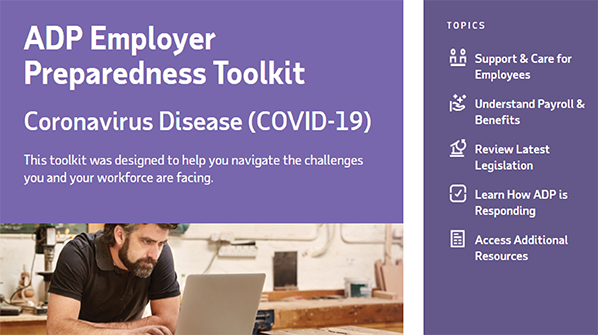Running payroll one of the most important responsibilities for business owners, but it doesn’t have to be the most stressful. With the right payroll management system, employers may be able to achieve peace of mind and find more time to focus on growing their business.

What is a payroll management system?
Put simply, a payroll management system is the process by which employers pay wages to their employees. It’s also how they demonstrate their commitment to their workers, fulfill their obligations to government agencies and keep financial records in order.
Why is payroll management important?
Payroll management is an important part of any business because it helps improve employee engagement and regulatory compliance. Without an efficient, accurate means of paying employees, depositing and filing taxes, and maintaining records, employers could face wage claims and expensive penalties.
What are some methods of payroll management?
Depending on their budget and desired level of involvement, employers have several options to choose from for payroll management, including:
- Manual payroll management using spreadsheets
Employers with a few employees may opt to manage payroll using a manual method, such as spreadsheets. The potential cost savings, however, are usually outweighed by the pitfalls. Manual DIY processes increase the risk of costly mistakes and take time away from activities that drive business growth. - Payroll management software
High-quality payroll software saves time and alleviates administrative burdens by automating labour-intensive tasks. Employers can rely on it to calculate gross wages, deductions and net pay accurately, while allowing them to maintain some control over the process. - Outsourcing
Employers that are interested in taking payroll off of their plate entirely often engage an administrative services payroll provider or enter into co-employment with a professional employer organization (PEO). In arrangements such as these, all aspects of payroll administration – including tax deposits, reporting and compliance – may be fully managed by the provider or PEO.
What are the phases of the payroll management process?
Regardless of how employers choose to manage payroll, the process generally consists of three phases:
- Pre-payroll
Employers gather relevant data for the pay period based on defined company policies and regulatory requirements, including hours worked by non-exempt employees, exception time (i.e., vacation, sick, jury duty, etc.) and employee adjustments, such as new hires, separations, salary increases or changes to benefit deductions and tax withholdings. This information is then verified and used to process payroll. - Calculations
Employers calculate the total gross pay each employee earned during the pay period and withhold taxes and deductions, resulting in net pay. They also accrue their own tax liability for the same time frame. - Post-payroll
Employers reconcile their payroll, deposit their taxes by the appointed due date and process any related payments, such as wage withholding orders. Additionally, they compensate their employees, along with a pay stub or wage statement, which is required in most jurisdictions.
What are the functions of a payroll management system?
The following functions, performed with attention to detail and a watchful eye on evolving regulations, are often necessary to transition through each phase of payroll management successfully.
Calculate employee wages
Through time sheets or time and attendance software, employers must accurately track the hours worked by non-exempt employees each workweek to correctly calculate pay. Time tracking isn’t as crucial for salaried employees because their gross pay is the product of their annual salary divided by the number of pay periods in the calendar year. However, some non-exempt employees may earn a salary, in which case, their hours must be tracked to ensure any overtime work is paid, as required by law.
Once gross wages are calculated for each employee, employers must process certain payroll deductions, including:
- Taxes
Employers deduct taxes based on their employees’ withholding certificates and total taxable wages. - Voluntary deductions
Written authorization from employees is required before an employer can deduct retirement plan contributions, health or life insurance premiums, or union dues. - Mandatory deductions
Employers will usually receive an official order from a government agency or court notifying them that they must withhold CRA or provincial tax garnishments, child support or other wage garnishments.
When all deductions are subtracted from the gross wages, the result is the employee’s net or take-home pay.
Process payroll taxes
Employers must calculate and withhold federal, state and local taxes from employee wages. The exact amounts are based on current tax rates and each employee’s Federal TD1 (most employees) or TD1X form (commissioned employees), Federal TD1-WS ,along with provincial claim forms and worksheets such as Quebec TP-1015.3-V, and TD1ON. Employers are also required to match employee contributions to Canada Pension Plan or Quebec Pension Plan, Employment Insurance, Quebec Parental Insurance Plan. Employers are solely responsible for provincial remittances for items such as Ontario EHT, Quebec HSF and CNESST, Manitoba and Newfoundland HAPSET, along with provincial Workers Compensation premiums. All payments must be sent to government agencies by the specified deadlines.
Comply with payroll recordkeeping requirements
Government agencies require employers to keep payroll records1 for every employee. This information typically includes:
- Name and occupation
- Address
- Social Insurance Number
- Day and time when an employee’s workweek began
- Number of hours worked each day and workweek
- The basis on which the employee’s wages were paid
- Regular hourly pay rate
- Total daily or weekly straight-time earnings
- Overtime earnings for each work week
- Gross wages
- Taxable benefits
- Payroll deductions
- Allowances claimed
- Net wages
- Date of each payment and the pay period that it covered
- Taxes withheld
- Forms - Federal TD1 (most employees) or TD1X form (commissioned employees), Federal TD1-WS, along with provincial claim forms and worksheets such as Quebec TP-1015.3-V, and TD1ON
Records required for federal tax purposes have to be kept on file for at least seven years; all other records must be retained in accordance with the various laws that apply to the business. If it is subject to both federal and provincial regulations, it needs to observe the one with the greater time frame. When in doubt, employers should check with the appropriate agency to make sure they’re keeping the right documents for the correct length of time.
Provide employees with pay statements
For the purpose of transparency, most provinces mandate that businesses provide their employees with pay statements at the time they receive their wages. Generally, the rates of pay, hours worked, gross pay, net pay and deductions must be displayed for each pay period. In addition, there are laws governing the delivery of electronic pay statements and how employees access them. To avoid violations, employers should contact their provincial labour standards agencies for specific requirements.
What are the benefits to using payroll management software?
Trying to become an expert in payroll is a painstaking process that leaves little room for business owners to improve their products or services. That’s why many rely on payroll management software, which frees up their time and affords them other key benefits, such as:
- Accurate calculations
Automation helps ensure that wage calculations, payroll deductions and tax payments are correct. - Compliance assistance
Some providers of payroll software notify employers about changes in employment or tax regulations that might affect their business. - Access to tax forms
Employers may have easy access to important tax documents – Form T4, Form T4A, Form R1, Form R2 and others – through their payroll software. - Flexible payments
In addition to traditional pay cheques, payroll software can usually accommodate direct deposit. - Detailed recordkeeping
Many digital payroll systems create employee profiles with various payroll records that can be aggregated and downloaded to meet regulatory requirements. - Employee self-service
Through a mobile app or computer, employees may be able to edit their personal information, change deductions, submit tax withholding information, view pay statements and more. - Reduced payroll errors
Payroll software that can integrate with time tracking and HR programs cuts back on repetitive data entry, thereby helping prevent errors. - Automatic alerts
Many payroll systems offer workflow notification. When the software detects a data entry error, if configured, it can send an alert to users so they can correct it before payroll is processed.
How to choose a payroll management system
The right payroll management system is generally capable of delivering accurate and timely payroll processing and tax filing services backed by expert knowledge and integrated technology. To find such a solution, business owners should ask these questions:
- Does the cost fit budgets or expected growth?
Small businesses with minimal financial resources might opt for basic payroll functions, while organizations that anticipate growth may be willing to spend more for robust capabilities. - What is the provider’s reputation and experience level?
Reputable payroll vendors tend to have longstanding clients who are willing to speak about the quality of the services they received. And the more years that a provider has been working in a particular industry, the more likely they will understand the applicable laws and compliance issues. - How secure is the service?
Encryption, firewalls, multi-factor authentication and back-up practices are essential to maintaining confidentiality and integrity. Payroll providers that take security seriously can usually demonstrate these and any other measures they use to protect data. - Is the software compatible with other programs?
Employers should ensure that their payroll provider offers seamless integrations with time tracking, HR and any other existing programs. - What are the reporting capabilities?
Some payroll providers can help ensure that new hire reports, annual reports and other documents are filed with the appropriate government agencies on time and include all of the required information.
How ADP can help businesses with payroll management
For more than 40 years, businesses small and large have trusted ADP for payroll management. Our flexible, affordable solutions can help organizations save time and money thanks to features, such as:
- Automated wage and tax calculations
- User-friendly self-service apps for employees
- Flexible payment options – pay cheque, and direct deposit
- Tax withholding and payments made on behalf of the client
- Support with compliance issues and reporting requirements
- Hassle-free integration with time tracking and HR programs
Learn more and compare our available payroll management options >
Frequently asked questions about payroll management
What is the meaning of payroll management?
Payroll management is the administrative task of compensating employees for services rendered. It also provides a financial record of employee gross earnings, payroll deductions and net pay, as well as the employer’s related payroll tax liability.
How do I do payroll management?
Payroll management can be a difficult, time-consuming process without reliable software to automate calculations and minimize errors. In its most basic form, running payroll consists of these steps:
- Calculate gross pay
For salaried employees, divide the annual salary by the total number of pay periods in the year. For hourly employees, multiply the hourly rate by the total number of hours worked and comply with federal and provincial laws for the payment of any overtime or premium compensation. Note that employers with non-exempt employees who are paid a salary will have to accurately track time and attendance like they would for hourly workers. - Withhold deductions
Calculate and withhold from gross wages any deductions that reduce income tax (such as employee RPP and RRSP contributions), followed by federal and Quebec income tax, Canada Pension Plan and Quebec Pension, Employment Insurance, Quebec Parental Insurance Plan, disability or paid family leave premiums, court-ordered wage garnishments and any other voluntary or mandatory deductions. - Pay employees
Distribute net pay to employees in accordance with provincial wage payment regulations and provide each employee a pay statement that adheres to provincial laws, if required. - Remit taxes to government agencies
Calculate and deposit employer taxes (i.e., federal and Quebec income taxes, Employment Insurance (employer & employer), CPP/QPP (employee and employer), QPIP premiums (employee and employer), Ontario EHT, Quebec HSF & CNESST, Manitoba and Newfoundland HAPSET, and Nunavut & Northwest Territories payroll, and provincial workers comp premiums by the specified deadlines using the appropriate submission methods. - Archive payroll records
Refer to federal and provincial payroll recordkeeping laws to ensure that the necessary documents are retained in accordance with each of the requirements.
What are the six steps in managing a payroll system?
Maintaining or creating a payroll management system for the first time may consist of these steps:
- Apply for an employer identification number (EIN)
A BN, which can be obtained from the CRA, is necessary to file payroll taxes. Employers may also need to apply for provincial identification numbers, and Workers Compensation numbers for each province and territory they operate in. - Gather employee tax documents
Form TD1, or TD1X form (commissioned employees), Federal TD1-WS along with provincial claim forms and worksheets such as Quebec TP-1015.3-V, and TD1ONvare required to help employers calculate employee payroll tax deductions. - Determine a payroll schedule
Common pay periods are weekly, bi-weekly and semi-monthly. - Document terms of compensation
Have clearly written policies explaining company requirements and laws for hours worked, overtime, paid time off, etc. In addition, it’s necessary to obtain each employee’s written consent for benefit contributions and other voluntary payroll deductions, as well as certain wage payment methods, like direct deposit versus pay cheque. - Choose a method for processing payroll
Businesses can manage payroll in-house or choose to outsource the process to a payroll service provider for optimal time savings and compliance support. - Open a bank account for payroll
Separate payroll accounts often lead to better management of funds, easier reconciliation and more accurate payroll transaction records.
What is a payroll system?
A payroll system is any means of paying employees, depositing employment taxes and maintaining records of the transactions. These tasks can be accomplished via manual processes or they can be automated with software to help save time and minimize the risk of error.
This guide is intended to be used as a starting point in analyzing an employer’s payroll obligations and is not a comprehensive resource of requirements. It offers practical information concerning the subject matter and is provided with the understanding that ADP is not rendering legal or tax advice or other professional services.
1There are additional requirements for the basic records that an employer must maintain under various federal and provincial laws. Remember to check each jurisdiction’s requirements for compliance.




